
In a box of miscellaneous parts a widow of a friend of mine gave me recently was a set of range rods. He used these to check the timing and alignment of revolvers that he worked on. I never learned how he did that as it wasn’t important at the time. Any information you could share on how to use range rods would be greatly appreciated.
James Flynn
Tyler, TX
Range Rods are precision-ground, steel inserts threaded on one end and padded on the other that are inserted into the muzzle of a revolver to check the alignment of the barrel with the chambers of the cylinder. This alignment is critical in achieving the best accuracy out of a revolver—particularly pertinent when shooting lead bullets. If one or more of the chambers in a revolver cylinder are out of alignment with the forcing cone of the barrel, bullets of any type will obturate differently, resulting in dissimilar impacts on the target. With lead bullets, this misalignment can cause “spitting,” which equates to particles of lead being ejected to the side of the gun at the barrel-cylinder gap. This could be dangerous to the shooter and any bystanders. The damage to the bullet as it transitions from the cylinder into the barrel often leaves excessive lead deposits in the barrel, which degrades accuracy and makes cleaning more difficult.
The first step before using a range rod is to check the timing of the revolver. If the timing is off, there is little a range rod will tell you that isn’t already obvious. Keep in mind that timing and barrel/cylinder alignment aren’t the same thing. The revolver can test well for timing and still not have optimum barrel/cylinder alignment, which is why range rods are of value when maximizing a revolver’s potential.
Checking the timing of revolvers is a fairly simple and straight-forward process:
First, unload the revolver and secure the ammunition elsewhere. Next, slowly pull the hammer back, watching the bolt release the cylinder and allowing it to turn, indexing the next chamber with the barrel. Before the hammer reaches the full-cock position, the bolt should reset and engage the notch in the cylinder, locking it in position. This should be done slowly and carefully for each chamber in the cylinder.
For revolvers having double-action capability, the same process should be repeated using the trigger to cock the hammer. The cylinder should be released, indexed and locked in place prior to the hammer falling on each chamber.
Should the bolt not lock the cylinder in place once the cylinder stops turning, there are more problems with the revolver that go beyond the scope of my answer to your original question. The place to look if that were the case would be the engaging surfaces of the hand with the ratchet portion of the cylinder.
Assuming the timing of the revolver is satisfactory, the barrel/cylinder alignment can be checked with the range rod corresponding to the caliber of the revolver.
Prepare the range rod for insertion into the muzzle of the revolver by attaching a length of cleaning rod to the threaded end long enough for the padded end to contact the recoil shield. Since the range rod is designed to ride the lands of the barrel closely, a little light lubricant will help the process.
It should be noted that the barrel and cylinder should be totally clean prior to inserting the range rod to prevent a false impression due to fouling.
To check the barrel/cylinder alignment, carefully push the range rod through the barrel to the recoil shield. No additional resistance should be felt as the range rod transitions through the barrel and cylinder. If resistance is felt, mark the location of the range rod for further investigation as to what is restricting the movement.
Once all chambers of the cylinder are checked in a like manner, providing no resistance is encountered, the timing and barrel/cylinder alignment of the revolver is verified as good.
If the range rod does not make a smooth transition from the barrel to the cylinder, it usually means a trip to a competent revolver smith—especially if the timing tests are good.
Range rods are a valuable tool when diagnosing a variety of problems (that aren’t readily obvious) one might experience with a revolver. It is essential for the chambers of the cylinder and the forcing cone of the barrel to be in alignment for optimum performance with a revolver.





































